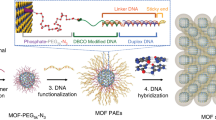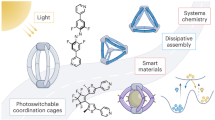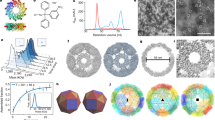Abstract
Metal–nucleic acid cages are a promising new class of materials. Like metallo-supramolecular cages, these systems can use their metals for redox, photochemical, magnetic and catalytic control over encapsulated cargo. However, using DNA provides the potential to program pore size, geometry, chemistry and addressability, and the ability to symmetrically and asymmetrically position transition metals within the three-dimensional framework. Here we report the quantitative construction of metal–DNA cages, with the site-specific incorporation of a range of metals within a three-dimensional DNA architecture. Oligonucleotide strands containing specific environments suitable for transition-metal coordination were first organized into two DNA triangles. These triangles were then assembled into a DNA prism with linking strands. Metal centres were subsequently incorporated into the prisms at the pre-programmed locations. This unprecedented ability to position transition metals within a three-dimensional framework could lead to metal–DNA hosts with applications for the encapsulation, sensing, modification and release of biomolecules and nanomaterials.
This is a preview of subscription content, access via your institution
Access options
Subscribe to this journal
Receive 12 print issues and online access
$259.00 per year
only $21.58 per issue
Buy this article
- Purchase on Springer Link
- Instant access to full article PDF
Prices may be subject to local taxes which are calculated during checkout





Similar content being viewed by others
References
Aldaye, F. A., Palmer, A. L. & Sleiman, H. F. Assembling materials with DNA as the guide. Science 321, 1795–1799 (2008).
Lin, C., Liu, Y., Rinker, S. & Yan, H. DNA tile based self-assembly: building complex nanoarchitectures. ChemPhysChem 7, 1641–1647 (2006).
Gothelf, K. V. & LaBean, T. H. DNA-programmed assembly of nanostructures. Org. Biomol. Chem. 3, 4023–4037 (2005).
Seeman, N. An overview of structural DNA nanotechnology. Mol. Biotechnol. 37, 246–257 (2007).
Aldaye, F. A. & Sleiman, H. F. Modular access to structurally switchable 3D discrete DNA assemblies. J. Am. Chem. Soc. 129, 13376–13377 (2007).
Shih, W. M., Quispe, J. D. & Joyce, G. F. A 1.7-kilobase single-stranded DNA that folds into a nanoscale octahedron. Nature 427, 618–621 (2004).
Heilemann, M. et al. Reconfigurable, braced, three-dimensional DNA nanostructures. Nature Nanotech. 3, 93–96 (2008).
He, Y. et al. Hierarchical self-assembly of DNA into symmetric supramolecular polyhedra. Nature 452, 198–201 (2008).
Mitchell, N. et al. A DNA nanostructure for the functional assembly of chemical groups with tunable stoichiometry and defined nanoscale geometry. Angew. Chem. Int. Ed. 48, 525–527 (2009).
Mastroianni, A. J., Claridge, S. A. & Alivisatos, A. P. Pyramidal and chiral groupings of gold nanocrystals assembled using DNA scaffolds. J. Am. Chem. Soc. 131, 8455–8459 (2009).
Tanaka, K. et al. A discrete self-assembled metal array in artificial DNA. Science 229, 1212–1213 (2003).
Tanaka, K. et al. Programmable self-assembly of metal ions inside artificial DNA duplexes. Nature Nanotech. 1, 190–194 (2006).
Clever, G. H., Kaul, C. & Carell, T. DNA-metal base pairs. Angew. Chem. Int. Ed. 46, 6226–6236 (2007).
Mitra, D., Di Cesare, N. & Sleiman, H. F. Self-assembly of cyclic metal-DNA nanostructures using ruthenium tris(bipyridine)-branched oligonucleotides. Angew. Chem. Int. Ed. 43, 5804–5808 (2004).
Yang, H. & Sleiman, H. F. Templated synthesis of highly stable, electroactive, and dynamic metal-DNA branched junctions. Angew. Chem. Int. Ed. 47, 2443–2446 (2008).
Yoshizawa, M. & Fujita, M. Self-assembled coordination cage as a molecular flask. Pure Appl. Chem. 77, 1107–1112 (2005).
Seidel, S. R. & Stang, P. High-symmetry coordination cages via self-assembly. Acc. Chem. Res. 35, 972–983 (2002).
Pluth, M. D., Bergman, R. G. & Raymond, K. N. Acid catalysis in basic solution: A supramolecular host promotes orthoformate hydrolysis. Science 316, 85–88 (2007).
Rowsell, J. L. C. et al. Gas adsorption sites in a large-pore metal-organic framework. Science 309, 1350–1354 (2005).
Chandler, B. D., Cramb, D. T. & Shimizu, G. K. H Microporous metal-organic frameworks formed in a stepwise manner from luminescent building blocks. J. Am. Chem. Soc. 128, 10403–10412 (2006).
Ghosh, S. K. et al. A bistable porous coordination polymer with a bond-switching mechanism showing reversible structural and functional transformations. Angew. Chem. Int. Ed. 47, 8843–8847 (2008).
Aldaye, F. A. & Sleiman, H. F. Dynamic DNA templates for discrete gold nanoparticle assemblies: control of geometry, modularity, write/erase and structural switching. J. Am. Chem. Soc. 129, 4130–4131 (2007).
Champin, B., Mobian, P. & Sauvage, J.-P. Transition metal complexes as molecular machine prototypes. Chem. Soc. Rev. 36, 358–366 (2007).
Armaroli, N. et al. Absorption and emission properties of a 2-catenand, its protonated forms, and its complexes with Li+, Cu+, Ag+, Co+, Ni2+, Zn2+, Pd2+ and Cd2+: tuning of the luminescence over the whole visible spectral region. J. Chem. Soc. Dalton Trans. 21, 3241–3247 (1993).
Acknowledgements
The authors thank NSERC, CFI, CSACS, CIHR and CIFAR for financial support, Jean-Pierre Sauvage for helpful discussion and J. Hedberg for help in preparing graphical illustrations. I.R. is recipient of a CIHR New Investigator award. G.D.H. thanks McGill University for a Tomlinson fellowship and C.K.M. thanks CIHR for a Chemical Biology scholarship. H.F.S. is a Cottrell Scholar of the Research Corporation.
Author information
Authors and Affiliations
Contributions
H.F.S., H.Y., C.K.M. and F.A.A. designed the project. I.R., G.D.H. and C.K.M. collected and analysed electron microscope data. H.Y., C.K.M., G.D.H. and A.Z.R. primarily contributed to the production of experimental results. H.F.S., H.Y. and C.K.M. were primarily responsible for preparing the manuscript and all authors have agreed to the content of the manuscript.
Corresponding author
Supplementary information
Supplementary information
Supplementary information (PDF 1850 kb)
Rights and permissions
About this article
Cite this article
Yang, H., McLaughlin, C., Aldaye, F. et al. Metal–nucleic acid cages. Nature Chem 1, 390–396 (2009). https://doi.org/10.1038/nchem.290
Received:
Accepted:
Published:
Issue Date:
DOI: https://doi.org/10.1038/nchem.290
This article is cited by
-
Exploring the diverse biomedical applications of programmable and multifunctional DNA nanomaterials
Journal of Nanobiotechnology (2023)
-
Self-assembly of DNA Nanostructures via Bioinspired Metal Ion Coordination
Chemical Research in Chinese Universities (2020)
-
Design formalism for DNA self-assembly of polyhedral skeletons using rigid tiles
Journal of Mathematical Chemistry (2018)
-
DNA nanotechnology
Nature Reviews Materials (2017)
-
Reprogramming the assembly of unmodified DNA with a small molecule
Nature Chemistry (2016)



